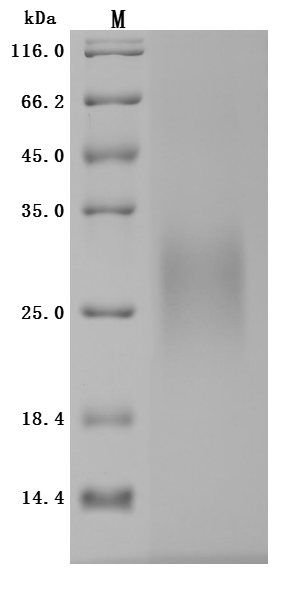
IGFLR1 (human):Fc (human) (Prod. No. AG-40B-0087) binds to its ligand IGFL-3 (human) (Prod. No. AG-40B-0090). Method: IGFLR1 (human):Fc was coated on an ELISA plate at 1microg/ml overnight at room temperature. IGFL-3 (human) or a negative control
IGFLR1 (human):Fc (human) (rec.)
AG-40B-0087
Protein IDQ9H665
Product group Proteins / Signaling Molecules
Overview
- SupplierAdipoGen Life Sciences
- Product NameIGFLR1 (human):Fc (human) (rec.)
- Delivery Days Customer10
- CertificationResearch Use Only
- Concentration1 mg/ml
- Estimated Purity>95%
- Protein IDQ9H665
- Protein NameIGF-like family receptor 1
- Scientific DescriptionInsulin-growth factor-like gene family is a new family of proteins consisting of four proteins in humans (IGFL1 to 4) and one in mice (mIGFL). mIGFL is expressed in normal skin in mice and further upregulated during inflammation responses in skin or after skin wounding. In human only IGFL1 expression is increased in psoriatic skin samples. mIGFL and human IGFL1 and 3 interact with specificity and high affinity to a novel receptor named IGF-like family receptor 1 (formerly TMEM-149). Analysis of the amino acid sequence of IGFLR1 indicated that this receptor is likely a novel member of the TNF-R family. IGFLR1 is expressed most abundantly on mouse T cells, suggesting that mIGFL and IGFL1 produced in the skin may potentially exert regulatory functions on T cell responses. - Protein. Human IGFLR1 (aa 23-154) is fused at the C-terminus to the Fc portion of human IgG1. Source: HEK 293 cells. Endotoxin content: 95% (SDS-PAGE). Insulin-growth factor-like gene family is a new family of proteins consisting of four proteins in humans (IGFL1 to 4) and one in mice (mIGFL). mIGFL is expressed in normal skin in mice and further upregulated during inflammation responses in skin or after skin wounding. In human only IGFL1 expression is increased in psoriatic skin samples. mIGFL and human IGFL1 and 3 interact with specificity and high affinity to a novel receptor named IGF-like family receptor 1 (formerly TMEM-149). Analysis of the amino acid sequence of IGFLR1 indicated that this receptor is likely a novel member of the TNF-R family. IGFLR1 is expressed most abundantly on mouse T cells, suggesting that mIGFL and IGFL1 produced in the skin may potentially exert regulatory functions on T cell responses.
- Storage Instruction-20°C,2°C to 8°C
- UNSPSC12352202


